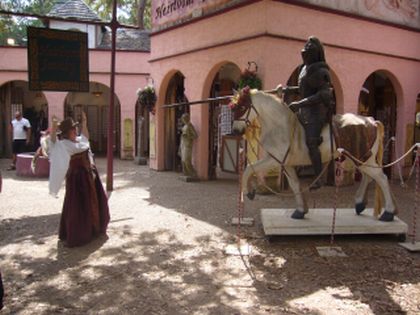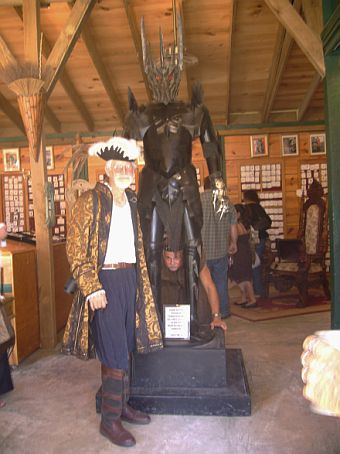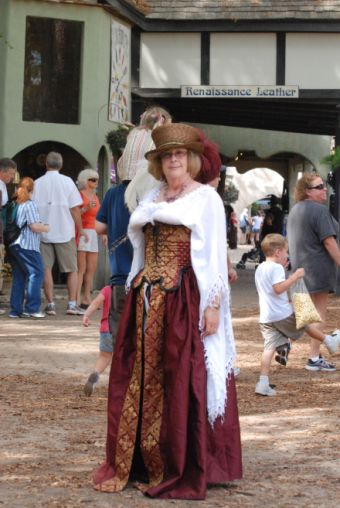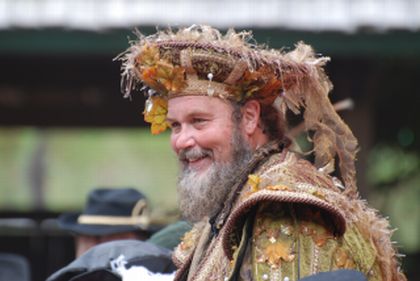|
Galleries: Many Faces of the Renaissance Festival
Bill and I were invited by two friends, Brenda and Don, to come join them at the Renaissance Festival outside of Houston, Texas. Apparently, it is the largest Renaissance Festival in the United States. This was a unique experience. We enjoyed all the flavors--costumes, food, dance, music, color, history, jousting, etc. The two days were fun-filled packed with sensory delight.
 
Bill (left) and Deb (right)  
Don (left) and Don and Brenda (right)  
Bill and Don in Don and Brenda's shop (left) and Deb (right) 
The King A Renaissance fair, Renaissance faire, or Renaissance festival is an outdoor weekend gathering, usually held in the United States, open to the public and typically commercial in nature, which emulates a historic period for the amusement of its guests. Some are permanent theme parks, others are short-term events in fairgrounds or other large public or private spaces. Renaissance fairs generally include an abundance of costumed entertainers, musical and theatrical acts, art and handicrafts for sale, and festival food. Some even offer camping, for those who wish to stay more than one day. Most Renaissance fairs are set during the reign of Queen Elizabeth I of England. Some are set earlier, during the reign of Henry VIII, or in other countries, such as France, and some include broader definitions of the Renaissance which include earlier periods, such as the Vikings, or later, such as 18th Century pirates, and some engage in deliberate "time travel" by encouraging participants to wear costumes representing several eras in a broad time period. Renaissance fairs encourage visitors to enter into the spirit of things with costumes and audience participation. Most tolerate, and many welcome, fantasy elements such as wizards and elves.
Chicago journalist Neil Steinberg said (of the Bristol Renaissance Faire), "If theme parks, with their pasteboard main streets, reek of a bland, safe, homogenized, whitebread America, the Renaissance Faire is at the other end of the social spectrum, a whiff of the occult, a flash of danger and a hint of the erotic. Here, they let you throw axes. Here are more beer and bosoms than you'll find in all of Disney World."
Characteristics
Most Renaissance fairs are arranged to represent an imagined village in England during the reign of Elizabeth I, as this period has been generally considered to correspond to the flowering of the English Renaissance.
In a modern Renaissance festival there are stages or performance areas set up for scheduled shows, such as plays in Shakespearean or commedia dell'arte tradition, as well as anachronistic audience participation comedy routines. Other performances include dancers, magicians, musicians, jugglers, and singers. Between the stages the streets ('lanes') are lined with stores ('shoppes') and stalls where independent vendors sell medieval and Renaissance themed handcrafts, clothing, books, and artworks. There are food and beverage vendors, as well as game and ride areas. Games include basic skills events such as archery or axe-throwing as well as Drench-a-Wench and Soak-a-Bloke, which allow a player with a good aim to hit a target and get a fair employee wet. Rides are typically unpowered-various animal rides and human-powered swings are common. Live animal displays and falconry exhibitions are also commonplace. Larger Renaissance fairs will often include a joust as a main attraction.
Fantasy elements, such as centaurs, are welcomed at some Renaissance fairs. In addition to the staged performances, a major attraction of Renaissance fairs is the crowds of actors - both professional and amateur - who play all sorts of historical figures and roam the fair, interacting with visitors. Visitors are encouraged to wear costumes, once any weapons are suitably peace-bonded, contributing to the illusion of an actual Renaissance environment. Many of the fair vendors sell or rent costumes for all ages and types. The Renaissance fair subculture's word for these costumed guests is "playtrons", a portmanteau of the words "patron" and "player", and they add a second level of enjoyment to their experience by "getting into the act" as Renaissance Lords and ladies, peasants, pirates, belly dancers, or fantasy characters.
Most fairs have an end-of-the-day ritual, a parade or concert where all employees gather and bid farewell to the patrons. For those who work at the fair, the last concert that a festival holds for the season is traditionally an emotional moment.
Renaissance fairs are staged around the United States at different times of the year. Fair vendors, participants and crew often work the "faire circuit", going from event to event as one fair ends and another begins. They often camp on-site or nearby and develop close bonds with their fellow performers.
History of the Fairs in America
In post-World War II America, there was a resurgence of interest in medieval and Renaissance culture. In the 1950s, there was a very strong early music revival, and out of that came folk musician and traditionalist John Langstaff. In 1957, Langstaff held "A Christmas Masque of Traditional Revels" in New York City, and the following year another in Washington, D.C. A televised version was broadcast on the "Hallmark Hall of Fame" in 1966 which included Dustin Hoffman playing the part of the dragon slain by Saint George, and in 1971 Langstaff established a permanent Christmas Revels in Cambridge, Massachusetts.
In 1963, Los Angeles schoolteacher Phyllis Patterson held a very small Renaissance fair as a class activity, in the backyard of her Laurel Canyon home in the Hollywood Hills. On May 11 and 12 of that year, Phyllis and her husband Ron Patterson, presented the first "Renaissance Pleasure Faire" as a one-weekend fundraiser for radio station KPFK, drawing some 8,000 people.
The fair was designed by the Living History Center to resemble an actual spring market fair of the period. Many of the original booths were no-charge reenactments of historical activities including printing presses and blacksmiths. The first commercial vendors were mostly artisans and food merchants and were required to demonstrate historical accuracy or plausibility for their wares. Groups of volunteers were organized into "guilds" to focus on specific reenactment duties (musicians, military, celtic clans, peasants, etc). Both actors and vendors were required to successfully complete workshops in period language and accents, costuming, and culture, and to stay "in character" while working.
For many years thereafter, the Renaissance Pleasure Faire of Southern California (RPFS) was held in the spring at the Paramount Ranch located in Agoura, California, partaking of the rich lore and age-old customs of English springtime markets and "Maying" customs. Five years later, the Pattersons created a fall Renaissance fair, with a harvest festival theme, first at what is now China Camp State Park in San Rafael, California and two years later at the Black Point Forest in Novato, California. Both fairs developed into local traditions and began a movement that spread across the country, though fairs that copied the original frequently did not attempt such historical accuracy.
An American Phenomenon?
Although historical reenactments are by no means exclusive to the United States (for example, the Earl of Eglinton in Scotland sponsored a large tournament in 1839), the Renaissance fair is, arguably, a uniquely American variation on the theme, having as much the flavor of an amusement park combined with a shopping mall as of a historical reenactment. European historical fairs, on the other hand, operate more on the living history museum model, in which an actual historic site is peopled by reenactors whose job it is to explain historical life to modern visitors. American Renaissance fair patrons may be as interested in drinking, eating, shopping, and watching farce as they are in an educational experience.
In recent years, American-style Renaissance fairs have made inroads in other countries. Germany has seen a very similar phenomenon since the 1980s (see de:Mittelaltermarkt), and beginning in the mid-1990s, Renaissance fairs have spread into Canada.
Spinoffs of Renaissance fairs also include fairs set in other time periods, such as Christmas fairs set in Charles Dickens' London. The American approach has apparently been exported back to England; a warehouse-based theme park, "Dickens World", opened in Kent, England, in May 2007.
Myths and Lore
The jousting and swordplay on exhibit in most Renaissance fairs is not real combat. As with professional wrestling, these "fights" are often carefully scripted mock combat. The weapons are real, but the participants are skilled, trained actors and stunt performers. Some jousting troupes, however, do perform real lance passes (using real pine lances).
 
The above pictures are copyright HorseHints.org Although the stocks and pillories displayed in some Renaissance fairs look alarming, they are not actually functional. They are provided for amusing photo opportunities and for entirely fictional stunt acts by professional actors.
Acts at a Renaissance fair usually have years of skill behind them and are highly choreographed, taking weeks of classes and, in some respects, years of practice in order to make it appear as authentic as possible.
Names
Renaissance fairs have several variant names, many of which use old-fashioned spellings such as faire or fayre. These spellings originate from the Middle English feire (variant spellings include feyre, faire, and fayre), which comes from the Anglo-French word feire. They can also be referred to as "Elizabethan", "Medieval", or "Tudor" fairs or festivals. "Ren Fair" and "Ren Fest" are popular colloquialisms. A German Mittelaltermarkt (literally "medieval market") is very similar to a Renaissance fair.
Controversies
Within the Renaissance fair community, there is difference of opinion as to how authentic a fair ought to be. Some believe fairs should be as authentic an experience as possible, with educational aspects like European living history museums. Others believe that entertainment is the primary goal. Richard Shapiro, who founded what later became the Bristol Renaissance Faire, said he favors entertainment. "We were so authentic back then it was almost painful."
For More Information:
List of Renaissance Fairs
Renaissance Magazine
|